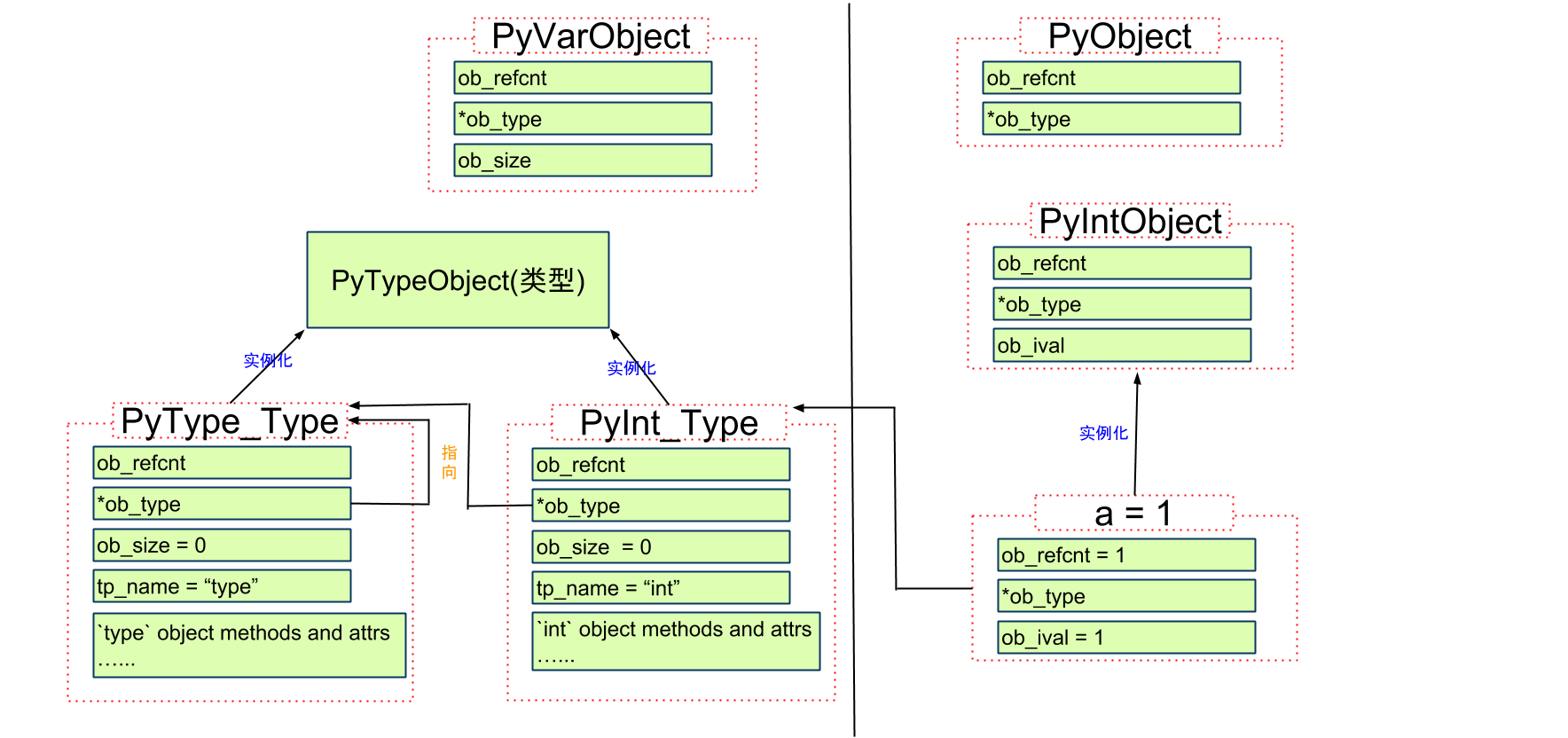对象
对象, 在c语言是如何实现的?
python中对象分为两类: 定长(int等), 非定长(list/dict等)
所有对象都有一些相同的东西, 源码中定义为pyobject和pyvarobject, 两个定义都有一个共同的头部定义pyobject_head(其实pyvarobject有自己的头部定义pyobject_var_head, 但其实际上用的也是pyobject_head).
源码位置: include/object.h
pyobject_head
python 内部, 每个对象拥有相同的头部.
定义
/* pyobject_head defines the initial segment of every pyobject. */
#define pyobject_head \
_pyobject_head_extra \
py_ssize_t ob_refcnt; \
struct _typeobject *ob_type;
说明
1. _pyobject_head_extra
先忽略, 双向链表结构, 后面垃圾回收再说
2. py_ssize_t ob_refcnt
py_ssize_t在编译时确定, 整型
ob_refcnt, 引用计数, 跟python的内存管理机制相关(基于引用计数的垃圾回收)
3. struct _typeobject *ob_type
*ob_type 指向类型对象的指针(指向_typeobject结构体)
决定了这个对象的类型!
pyobject
定义
typedef struct _object {
pyobject_head
} pyobject;
说明
1. 依赖关系
pyobject -> pyobject_head
结构
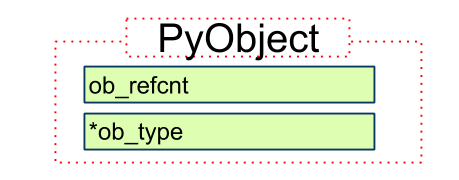
pyvarobject
定义
typedef struct {
pyobject_var_head
} pyvarobject;
#define pyobject_var_head \
pyobject_head \
py_ssize_t ob_size; /* number of items in variable part */
说明
1. 依赖关系
pyvarobject -> pyobject_var_head -> pyobject_head
2.py_ssize_t ob_size
ob_size, 变长对象容纳的元素个数
结构
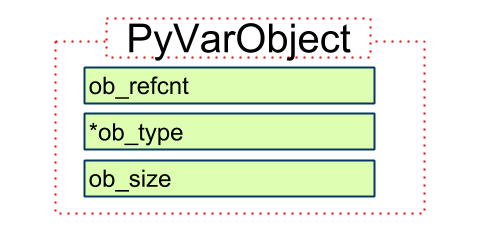
代码关系
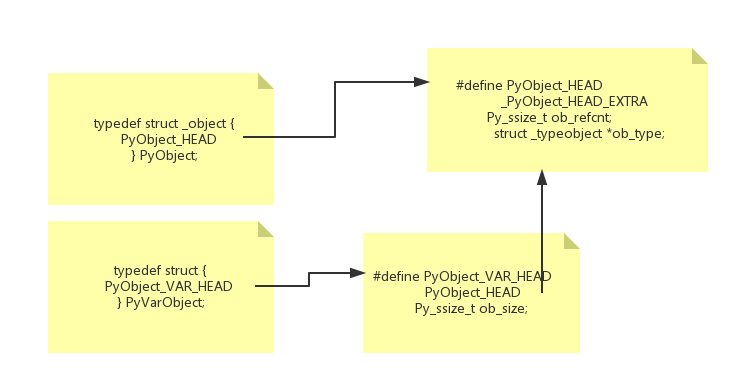
几个方法
跟对象相关的方法
#define py_refcnt(ob) (((pyobject*)(ob))->ob_refcnt)
读取引用计数
#define py_type(ob) (((pyobject*)(ob))->ob_type)
获取对象类型
#define py_size(ob) (((pyvarobject*)(ob))->ob_size)
读取元素个数(len)
跟引用计数相关的方法
py_incref(op) 增加对象引用计数
py_decref(op) 减少对象引用计数, 如果计数位0, 调用_py_dealloc
_py_dealloc(op) 调用对应类型的 tp_dealloc 方法(每种类型回收行为不一样的, 各种缓存池机制, 后面看)
其他
几个参数涉及
ob_refcnt 引用计数, 与内存管理/垃圾回收相关
ob_type 类型, 涉及python的类型系统
类型
一个例子
>>> a = 1
>>> a
1
>>> type(a)
#等价的两个
>>> type(type(a))
>>> type(int)
#还是等价的两个
>>> type(type(type(a)))
>>> type(type(int))
我们反向推导一个int对象是怎么生成的.
1. 首先, 定义一种类型叫pytypeobject
代码位置 include/object.h
定义
typedef struct _typeobject {
/* mark: base, 注意, 是个变长对象*/
pyobject_var_head
const char *tp_name; /* for printing, in format “.” */ //类型名
py_ssize_t tp_basicsize, tp_itemsize; /* for allocation */ // 创建该类型对象时分配的内存空间大小
// 一堆方法定义, 函数和指针
/* methods to implement standard operations */
printfunc tp_print;
hashfunc tp_hash;
/* method suites for standard classes */
pynumbermethods *tp_as_number; // 数值对象操作
pysequencemethods *tp_as_sequence; // 序列对象操作
pymappingmethods *tp_as_mapping; // 字典对象操作
// 一堆属性定义
….
} pytypeobject;
说明
1. pyobject_var_head
变长对象
2. const char *tp_name
tp_name, 类型名字符串数组
所有type都是pytypeobject的”实例”: pytype_type/pyint_type
2. 然后, 用pytypeobject初始化得到一个对象pytype_type
代码位置 objects/typeobject.c
定义
pytypeobject pytype_type = {
pyvarobject_head_init(&pytype_type, 0)
“type”, /* tp_name */
sizeof(pyheaptypeobject), /* tp_basicsize */
sizeof(pymemberdef), /* tp_itemsize */
(destructor)type_dealloc, /* tp_dealloc */
// type对象的方法和属性初始化值
…..
};
说明
1. tp_name
类型名, 这里是”type”
2. pyvarobject_head_init(&pytype_type, 0)
pyvarobject_head_init, 这个方法在 include/object.h中,
等价于
ob_refcnt = 1
*ob_type = &pytype_type
ob_size = 0
即, pytype_type的类型是其本身!
结构
第一张图, 箭头表示实例化(google doc用不是很熟找不到对应类型的箭头)
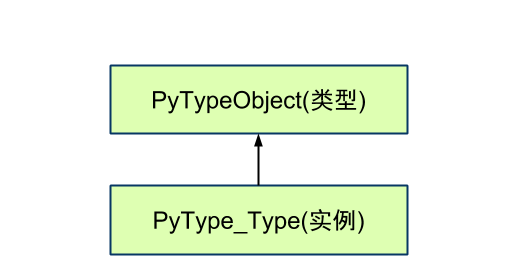
第二张图, 箭头表示指向
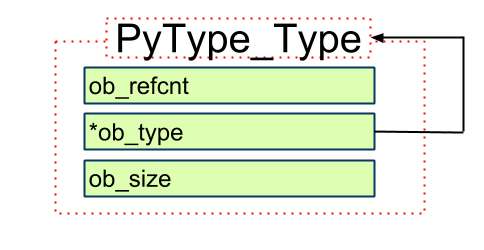
使用
# 1. int 的 类型 是`type`
>>> type(int)
# 2. type 的类型 还是`type`, 对应上面说明第二点
>>> type(type(int))
注意: 无论任何时候, ob_type指向的是 pytypeobject的实例: pytype_type/pyint_type…
3. 再然后, 定义具体的类型, 这里以pyint_type为例子
代码位置 objects/intobject.c
定义
pytypeobject pyint_type = {
pyvarobject_head_init(&pytype_type, 0)
“int”,
sizeof(pyintobject),
0,
// int类型的相关方法和属性值
….
(hashfunc)int_hash, /* tp_hash */
};
说明
1. “int”
pyint_type的类型名是int
2.pyvarobject_head_init(&pytype_type, 0)
pyint_type的
*ob_type = &pytype_type
结构
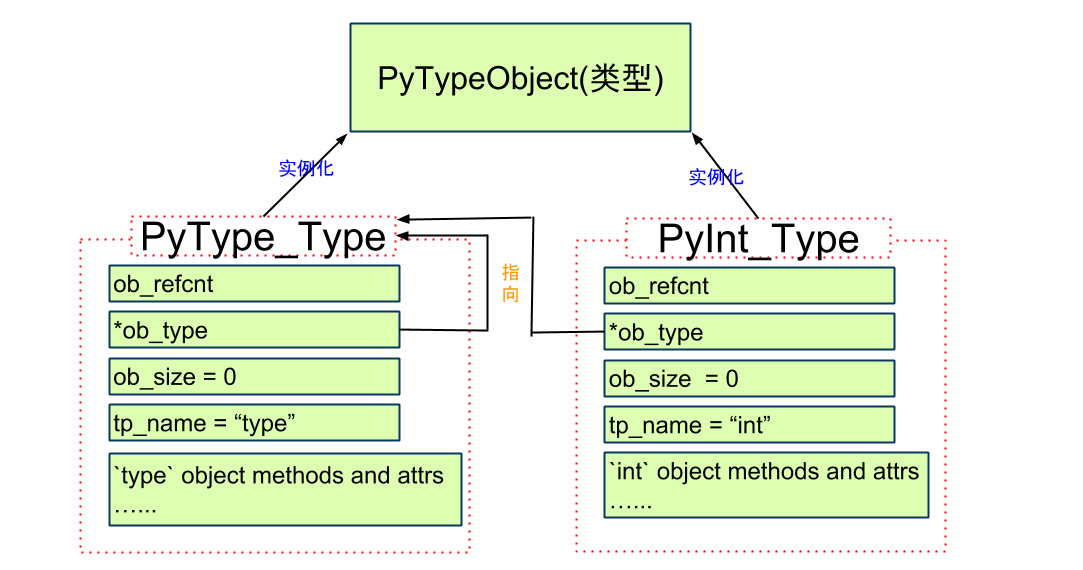
使用
>>> type(1)
>>> type(type(1))
4. 最后, 生成一个整数对象int
代码位置 include/intobject.h
定义
typedef struct {
pyobject_head
long ob_ival;
} pyintobject;
结构
